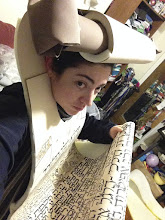
It’s here; it’s here! At long last, after months and month of waiting, it’s finally here. It’s prepared to meet your expectations, but simultaneously soar above them and thwart them in ways you’d never imagined. It makes perfect sense; it knows you better than you know yourself; it molds itself to the confines of your mind and clings to needs and wants and worries you’d never even imagined were there. And while at times it may be terrifying to behold, it leaves you with a glimmer of hope that millions of others like you, just as frightened, are standing alongside you, as you tentatively explore the same uncertain future together.
I’m talking, of course, about Google Wave.
Like Where the Wild
 Things Are, Google Wave finally crashed to the shore this month, after a seemingly endless wait. And like Where the Wild Things Are, I wanted to get there before anybody else, so I planned ahead and got my tickets to a midnight showing. Er, my invite from a Google-employed friend. The service is a big buggy, to be sure. This morning, for instance, I noticed that all my old waves had disappeared; if that happened with G-mail I’d be quaking in my boots. For now, Wave functions mostly as a toy – a shiny and comely and intuitive toy, of course – but until a larger chunk of the population switches over, the revolution won’t be arriving just yet.
Things Are, Google Wave finally crashed to the shore this month, after a seemingly endless wait. And like Where the Wild Things Are, I wanted to get there before anybody else, so I planned ahead and got my tickets to a midnight showing. Er, my invite from a Google-employed friend. The service is a big buggy, to be sure. This morning, for instance, I noticed that all my old waves had disappeared; if that happened with G-mail I’d be quaking in my boots. For now, Wave functions mostly as a toy – a shiny and comely and intuitive toy, of course – but until a larger chunk of the population switches over, the revolution won’t be arriving just yet. Where the Wild Things Are, on the other hand, upholds every aspect of its reputation. True to director Spike Jonze’s vision, we voyage not through an adult’s idyllic recollection of childhood, but through the raw experience of a nine-year-old mind. Camera angles knock jarringly against each other; the weather matches our mood; the lines between fantasy and reality blur as pieces of Max’s real world invade his dream.
Where the Wild Things Are, on the other hand, upholds every aspect of its reputation. True to director Spike Jonze’s vision, we voyage not through an adult’s idyllic recollection of childhood, but through the raw experience of a nine-year-old mind. Camera angles knock jarringly against each other; the weather matches our mood; the lines between fantasy and reality blur as pieces of Max’s real world invade his dream.The beasts Max
 envisions vaguely recall his real life: one Wild Thing not unlike his sister spends all her time with inscrutable new friends, while a male-female couple fill an ambiguous void in Max’s family. Carol, the Wild Thing voiced by James Gandolfini and only truly understood by Max himself, destroys houses (which resemble a knickknack from Max’s nightstand, and recall the events that precipitated Max leaving home) when he gets upset. More than characters Max knows, though, the Wild Things depict crude emotion, embodying Max’s range of destructive streaks, loneliness, confusion, fear, and at times, unfettered joy. They follow his whims and build the fort of his dreams, thanks to their beliefs in the myths Max tells about himself, and to their earnest engagement in his tales of one-upmanship that only authentic nine-year-olds would tell.
envisions vaguely recall his real life: one Wild Thing not unlike his sister spends all her time with inscrutable new friends, while a male-female couple fill an ambiguous void in Max’s family. Carol, the Wild Thing voiced by James Gandolfini and only truly understood by Max himself, destroys houses (which resemble a knickknack from Max’s nightstand, and recall the events that precipitated Max leaving home) when he gets upset. More than characters Max knows, though, the Wild Things depict crude emotion, embodying Max’s range of destructive streaks, loneliness, confusion, fear, and at times, unfettered joy. They follow his whims and build the fort of his dreams, thanks to their beliefs in the myths Max tells about himself, and to their earnest engagement in his tales of one-upmanship that only authentic nine-year-olds would tell.True to the not-always-sunny childhood experience (and to the original book), Max, unfit to run a world of his own design and populated by his own limited understanding, eventually returns home to his mother. After all the terrors of one’s own mind coming to life and the invocation of the audience’s inner fears, the capacity to come home to a warm dinner in a house with a caring parent has its appeal. It’s a little bit disappointing, in a way, this last truism of childhood: you’ll never be as free as you want to be.
But you never know. Maybe, with the aid of Google Wave and a little imagination, we can finally become that child’s vision of a grown-up, as free as we’d always wanted. We’ll have to wait and see where this journey takes us.


No comments:
Post a Comment